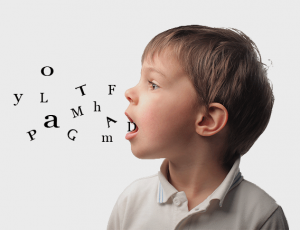Speech Disorders
Conveniently located to serve the areas of Santa Monica, Venice, South Bay, Brentwood, Beverly Hills, Pasadena and all of Greater Los Angeles
Contents
What are Speech Delays and Disorders

- Articulation Disorders
- Phonological Disorders
- Fluency Disorders (Stuttering)
- Voice and Resonance Disorders
- Motor speech disorders – Apraxia
Articulation Disorders/Phonological Disorders
Articulation and phonological disorders are speech sound disorders. Articulation represents the actions of the structures of speech in the production of speech sounds. The articulation system integrates of number of structures including: the breathing mechanism, the larynx, the pharynx, tongue, lips, teeth, mandible, hard palate, velum, oral cavity, and the nasal cavity. When any of these systems are not functioning appropriately, their may be a resulting articulation disorder. An articulation disorder occurs when the sounds of language are not produced correctly, interfering with the clarity and intelligibility of connected speech. Typically the sound errors are classified as omissions, substitutions, distortions, and additions. There are a variety of different reasons why this occurs ranging from developmental delays to motor speech disorders.
Phonological development is the process of acquiring the sounds of speech. Phonological rules describe the sound system of a language. These rules describe the following parameters of a language: the phonemes, the variations of the phonemes and the conditions for the appearance of these variations, and the allowable word positions and combinations of these phonemes into words. Most children learn these rules by the age of 5 or 6. When these rules are not learned or used appropriately the resulting speech will be unclear and misarticulated in some way.
Common Signs and Symptoms
- Lack of consonant production in early babbling
- Delayed development of the sounds of speech
- Mispronouncing sounds
- Substituting one sound for another consistently
- Leaving sounds out in words
- Poor speech clarity
- Delayed language development
- Delayed global development in other areas
- Reading difficulties
Treatment
There are several different treatment approaches for articulation and phonological disorders. Therapy will typically consist of a training program that can be delivered either individually or in a group setting with other children who are working on the same sounds. There are also several software based programs which address specific sounds or groups of sounds that are based on drill work. Generally speaking, most of the programs for articulation will focus on placement techniques, listening for sound features, and progressions from sound to syllable to word and finally phrase and sentence levels. Multi-sensory input is often used to help train the various aspects of the sound. Some programs use ear training to familiarize the patient with the sounds being trained and to help differentiate between correct productions of the target sound versus incorrect productions of the sound.
Fluency Disorders and Stuttering
Fluency is a speaker’s effortless flow of speech. What makes speech effortless is a combination of factors such as rhythm, rate, intonation patterns, clarity, cohesion of thoughts, and sequencing of information. Stuttering, which is also known as dysfluent speech, represents speech that is characterized by an abnormally excessive amount of stoppages or breaks in the flow of speech. These stoppages are characterized by any of the following: repetitions of sounds, syllable or words, prolongations of sounds, or blocks of airflow and/or voicing aspects during speech production, poor overall rate of speech and finally poor rhythmical patterning in speech.
Common Signs and Symptoms
- Presence of extra sounds in speech which may be repetitions of something, prolongations of sounds or words, or interjections
- Increased presence of pauses in connected speech
- Abnormal Rhythmic patterning of speech
- Intonation and stress deviant from normal speech
- Overall rate of speaking is either too slow or consists of bursts of faster rate interspersed with slower rate
Voice Disorders
A voice disorder is any abnormality in the production of one’s voice due to any combination of deficits in the various aspects of the vocal characteristics of pitch, loudness, resonance, and duration. An abnormality in this sense refers to any deviation from what is considered normal for the individual’s age and gender.
Motor Speech Disorders
A motor speech disorder is any disturbance of speech which is due to lesions or damage to the motor system in the brain. The two most common motor speech disorders are dysarthria and apraxia.
Dysarthria
This is a speech disorder that results from problems with muscular control that results from a single lesion, multiple lesion, or a diffuse lesion to the central or peripheral nervous systems. Dysarthria affects the strength and control of the muscles used for both speech and non-speech functions such as smiling and chewing. Symptoms of dysarthria include weakness of the articulators, slowness of response, fatigue, and or incoordination. These impairments can affect the processes of respiration, phonation, resonance, articulation, and prosody of speech. Dysarthria is common amongst individuals with neurological conditions or injuries such as cerebral palsy, muscular dystrophy, myopathies, facial palsy and head injury.
Apraxia
Apraxia is a term used to describe a motor speech programming disorder resulting in difficulties executing, coordinating and/or sequencing the oral motor movements necessary to produce and combine consonants and vowels to form words on voluntary muscle control. There are several terms that are used interchangeably to describe this disorder. These include apraxia of speech, verbal apraxia, and developmental apraxia of speech.
Apraxia is a speech disorder that results from a disruption of motor planning ability for speech production that occurs because of some type of brain dysfunction. Speech output is characterized by difficulties producing deliberate, volitional movements, even though there is no weakness, slowness, or incoordination resulting from muscular impairments. The programming of the muscles from the brain is incorrect or imprecise and therefore the errors tend to be inconsistent and unpredictable. Muscular control is completely intact. Individuals with apraxia in the absence of other co-occurring conditions, have normal cognitive abilities.
Common Signs and Symptoms
- Little or no cooing or babbling as an infant
- First words occurring after 18 months of age
- Non-verbal at age 2
- Persistent use of non-speech sounds or vocalizations without any word approximations
- Can produce sounds in isolation but cannot combine sounds
- Child who can say a word spontaneously but when asked to repeat it they cannot
- By age 3 has good speech clarity at the single word level but becomes unintelligible when producing phrases or sentences
- Has trouble making simple movements of the tongue, lops, or palate.
- May be a clumsy, showing signs of gross and fine motor incoordination
Co-Morbidities
The research in the field has suggested that there are some co-morbidities which seem to be prevalent amongst individuals with apraxia.
- Oral apraxia
- Hypotonia
- Sensory Integration Dysfunction
- Autism
- Gross and fine motor coordination issues
- Flaccid Dysarthria
- Auditory processing disorders
- Language processing disorders
- Hearing loss
Kaufman Speech Praxis Treatment
Apraxia therapy is quite intensive and regimented. It follows a course that is different from other speech intervention approaches. Due to the commonality of co-morbidities with other conditions, it is important to determine the primary root cause of the individual’s difficulties with speaking. An integrated approach may be necessary in order to address multiple issues.
The therapy tasks are provided in a hierarchy starting with simple, gross motor aspects of words and progressing to more complex consonant and vowel patterns and combinations.
One of the most effective approaches to treating apraxia is the Kaufman approach. This systematic approach is based upon shaping word approximations toward target vocabulary until the individual has increased motor-speech coordination and language processing skills. Individuals are taught the “shell” of words without including the most difficult motor movements. Their productions are then shaped towards the ability to say the word as a whole while being assisted with cures, fading cues, and using strategic behavior reinforcement.
Neurofeedback
Neurofeedback has been shown to contribute to improved treatment outcomes when used in conjunction with other treatment methods for apraxia. It has been beneficial in addressing the co-morbidities which impact overall speech, language and behavioral skills in these individuals.




